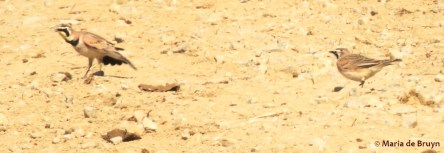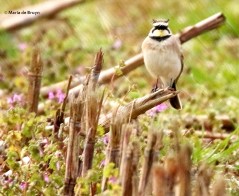 Although it’s taken me some time to process photos taken earlier this year, I’d still like to share what I was seeing in late winter and early spring when stopping at farm fields. These sometimes muddy and stubble-covered parcels of land can offer wildlife watchers nice views of birds and occasionally other animals, unobstructed by a lot of foliage. So visits to roadside farms and ponds were on my early 2019 nature-walk itineraries.
Although it’s taken me some time to process photos taken earlier this year, I’d still like to share what I was seeing in late winter and early spring when stopping at farm fields. These sometimes muddy and stubble-covered parcels of land can offer wildlife watchers nice views of birds and occasionally other animals, unobstructed by a lot of foliage. So visits to roadside farms and ponds were on my early 2019 nature-walk itineraries.
Farm fields are often bordered by stands of trees where animals can retreat if they become disturbed by humans standing around aiming long camera lenses at them. The white-tailed deer (Odocoileus virginianus) above were browsing one morning and seemed unconcerned as I photographed nearby birds. When I turned to watch them specifically though, they decided to move back into the woods bordering the field.
Many farmers put out bird boxes on fences bordering their fields; in early March, the Eastern bluebirds (Sialia sialis) were already checking out and starting to furnish potential nest sites. Here a male was flying away from a nest box while his mate was gathering pine needles.
The fences offer other birds a good vantage point for observation, too. A Northern flicker (Colaptes auratus) perched on a fence post to look around and then flew to a branch high above me.
 A bird present in large numbers was the brown-headed cowbird (Molothrus ater). One morning, a friend and I counted some 200 birds in one small group of trees. Many people think they are an invasive species and dislike these birds intensely because they evolved a behavior that can endanger other birds. The cowbirds, who are native to America, were originally present in prairies where they followed the buffalo. This meant they did not stay in one place long enough to tend a nest, so they began laying their eggs in other birds’ nests. The young cowbirds hatch first and then may throw out the other eggs or hatchlings or they eat so ravenously that the other nest mates don’t get enough.
A bird present in large numbers was the brown-headed cowbird (Molothrus ater). One morning, a friend and I counted some 200 birds in one small group of trees. Many people think they are an invasive species and dislike these birds intensely because they evolved a behavior that can endanger other birds. The cowbirds, who are native to America, were originally present in prairies where they followed the buffalo. This meant they did not stay in one place long enough to tend a nest, so they began laying their eggs in other birds’ nests. The young cowbirds hatch first and then may throw out the other eggs or hatchlings or they eat so ravenously that the other nest mates don’t get enough.
It certainly is disconcerting to see a small warbler feeding a large cowbird fledgling and a couple bird species have been endangered by the behavior. But I don’t dislike the cowbird because of this – they did not choose how to evolve and the behavior developed as an adaptation, not an “evil” practice. They are attractive birds. And the sounds they make are lovely, akin to water droplets falling into a pool.
The American robins (Turdus migratorius) were also present in abundance; they tend to flock together in the winter and early spring. One farm had a boggy area with some cyprus trees and the robins were busy looking for insects among the cyprus “knees” (Taxodium distichum). These woody structures that grow out of the roots may help stabilize the trees when they are standing in water but scientists have not yet definitively identified their purpose.
 There were other trees near the cypresses; in one, the cocoon of a Polyphemus moth (Antheraea polyphemus) was hanging high overhead. It also pays to look around to see who is flying u[ ahigh above those trees and fields. It’s not uncommon to see Canada geese (Branta canadensis) flying from one farm pond to another.
There were other trees near the cypresses; in one, the cocoon of a Polyphemus moth (Antheraea polyphemus) was hanging high overhead. It also pays to look around to see who is flying u[ ahigh above those trees and fields. It’s not uncommon to see Canada geese (Branta canadensis) flying from one farm pond to another.
Red-tailed hawks (Buteo jamaicensis) soared over different fields I visited.
Red-shouldered hawks (Buteo lineatus) also made an appearance.
And one of my favorite raptors often eluded my efforts to capture a portrait. Only a couple times was I able to catch a beautiful kestrel (Falco sparverius) speeding by in flight.
The robins were feeding in the fields as were several other bird species.
Yellow-rumped warbler (Setophaga coronata)
Savannah sparrow (Passerculus sandwichensis)
Pine warbler (Setophaga pinus)
 A pair of Northern mockingbirds (Mimus polyglottos) was taking advantage of numerous cow patties left behind on one farm field in their search for insects. They were flashing their wings repeatedly; I’m convinced that this was behavior designed to scare up bugs so they can catch them easily.
A pair of Northern mockingbirds (Mimus polyglottos) was taking advantage of numerous cow patties left behind on one farm field in their search for insects. They were flashing their wings repeatedly; I’m convinced that this was behavior designed to scare up bugs so they can catch them easily.
Other birds were following them around in the field, apparently taking advantage of the insect smorgasbord. Two of them were a song sparrow (Melospiza melodia) and a field sparrow (Spizella pusilla).
 This year, it was also my good fortune to see a bird new to me in one farm field, the lovely horned lark (Eremophila alpestris). Although these birds are not considered endangered, their numbers declined by 71% between 1966 and 2015.
This year, it was also my good fortune to see a bird new to me in one farm field, the lovely horned lark (Eremophila alpestris). Although these birds are not considered endangered, their numbers declined by 71% between 1966 and 2015.
I couldn’t get close to the larks but one day I did catch a bird taking a dust bath in a gravel and dirt road next to their preferred field. On a second visit to that farm, I again saw a lark in the road and then another lark joined it.
It turns out that female larks perform a courting display that looks very similar to actually taking a dust bath, so I got to see a mating behavior that I hadn’t expected!
Reading about the behavior, I discovered that if male larks see a female who is dust bathing, he may mistake what she’s doing and try to mate with her when she’s not ready.
 So reproductive life is a bit difficult for those males, who look so adorable when they raise those head feathers to project two little black horns.I will leave you here with a few more views of a horned lark who was singing and foraging not too very far from the road.
So reproductive life is a bit difficult for those males, who look so adorable when they raise those head feathers to project two little black horns.I will leave you here with a few more views of a horned lark who was singing and foraging not too very far from the road.





























Oh, such beauty!
LikeLiked by 1 person
Thanks, Cindy! Nature is always so interesting and wonderful to observe.
LikeLike
Oh I loved this blog! You described life around the farmlands perfectly. Great photos and such a variety of birds displayed. Thanks for sharing
LikeLiked by 1 person
Thanks, Karla – I had more photos of bird species but then the blog would have been even longer. Somehow I just don’t seem able to produce short blogs. 🙂
LikeLike
I really enjoyed your farmlands blog and reliving our trip to Raleigh to see the horned larks – and all the cowbirds!
LikeLiked by 1 person
Aw, thanks, Lucretia, for your comment! Those horned larks were pretty cool! And I’ll continue hoping to get a nice “perching” photo of a kestrel one day! 🙂
LikeLike
Rarely do people write about that in between time…when winter is still with us, but spring is inching in…a wonderful summary of some great days!
LikeLiked by 1 person
Thanks, Mary! Looking at photos from that time made it apparent to me once again that we really do get to see nice birds year-round, even when the vegetation is dormant and preparing for its spring rejuvenation!
LikeLike
Wonderful pictures! Maria, do you have binoculars with built in digital camera? What brand and what power? Keep up the great* adventures, and thank you for sharing. Howard M.
LikeLike
Thanks, Howard. I don’t have binoculars and have never heard of binoculars with a built-in digital camera. I use a Canon 7d II camera and either a 100-400 zoom lens or a 50-250 zoom lens. I’ll have to look into those types of binoculars!
LikeLike
Pingback: The Northern mockingbird boundary dance | My beautiful world